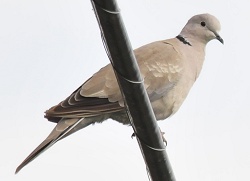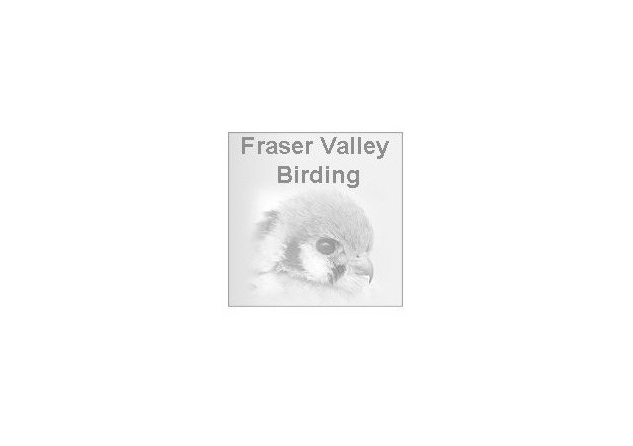The Eurasian Collared-Dove in the Upper Fraser Valley
By Gord Gadsden
Eurasian Collared-Doves are not native to North America but are establishing  themselves fairly quickly in many regions. Originally found in Asia, they spread westwards into Great Britain by the early 1950's. In the 1970's, they were introduced to the Bahamas. By early 1980, they were already found in Florida. They have continued to spread throughout North America and were first detected in the Upper Fraser Valley in the fall of 2005 with a single bird visiting a feeder in east Chilliwack. By 2009, over a dozen unique locations in the area had anywhere from one to over thirty birds present. Breeding was also first detected in 2009 although it no doubt had already occurred previously. How the first birds arrived to our area is not certain, currently no evidence points towards escapees from captivity. This species is kept as pets and ones that escape from captivity would no doubt hasten this species' spread. This species' has a history of successfully spreading to new areas in several unique places in the world. The incredible population growth we are currently documenting now would not come as much of a surprise if they managed to do it largely. if not completely, under their own power. themselves fairly quickly in many regions. Originally found in Asia, they spread westwards into Great Britain by the early 1950's. In the 1970's, they were introduced to the Bahamas. By early 1980, they were already found in Florida. They have continued to spread throughout North America and were first detected in the Upper Fraser Valley in the fall of 2005 with a single bird visiting a feeder in east Chilliwack. By 2009, over a dozen unique locations in the area had anywhere from one to over thirty birds present. Breeding was also first detected in 2009 although it no doubt had already occurred previously. How the first birds arrived to our area is not certain, currently no evidence points towards escapees from captivity. This species is kept as pets and ones that escape from captivity would no doubt hasten this species' spread. This species' has a history of successfully spreading to new areas in several unique places in the world. The incredible population growth we are currently documenting now would not come as much of a surprise if they managed to do it largely. if not completely, under their own power.
Life History
Eurasian Collared-Doves are a non-migratory species. They eat mostly seeds and grains, and will be a regular visitor to a backyard bird feeding station where they will feed mostly on the ground. Nesting takes place in trees, and coniferous tree species seem to be where most breeding activity might be taking place. A nest, made of grasses and twigs, usually contains two eggs. (Romagosa, 2002).
Impacts on Native Birds
It is not known what their impact on the ecosystem might be in terms of the ecological niche they occupy. One always thinks back to the introduction of the European Starling and House Sparrow and cringes. Both of those species displaced and continue to displace native bird species. The closest native species to possibly be displaced by the Eurasian Collared-Dove is the Mourning Dove, which are uncommon to rare in recent years even prior to the Eurasian Collared-Doves' arrival. The detections of Mourning Dove so far have remained consistent. Recently, a single Mourning Dove was seen associating with a small flock of Eurasian Collared-Doves in Sumas Prairie (Gadsden, 2011c). Further monitoring will no doubt provide more indication of this new species' effect.
Their Status in the Upper Fraser Valley
The rate that this species has spread in the Upper Fraser Valley is amazing since their initial discovery is 2005. It has been interesting to note that several locations have remained reliable throughout this time to see Eurasian Collared-Doves. Many of these areas have even increased in numbers. For example, a healthy population of birds can be found on Wells Line Road in Sumas Prairie where an excess of 70 birds have been counted at once towards the end of 2010. Given the data collected and distance between 'sites', it is highly unlikely, but not impossible, that birds are being double counted. Many of the sightings occurred over a short time period in one day further reducing the probability of the same birds or group of birds being recorded as separate encounters. Sighting locations usually remain reliable to see the birds over several months suggesting once they find habitat and a food supply, they do not tend to roam very far. Even when a group pops up a several kilometers away, roughly the same amount of birds are being seen in the original areas. While not strictly scientific, data collected still undoubtedly displays a fairly good portrayal of this species' status in our area. Data from the Christmas Bird Count for Chilliwack over the last four years also supports the general findings. See the series of maps below to view the data.
Expansion in Sumas Prairie and Chilliwack continues as well as several new locations this year. New areas of detection for 2011 include Laidlaw, Hope, Harrison Lake, Harrison Mills and Mission. Over the coming months, areas such as Deroche, Hatzic Prairie, Seabird Island, Cultus Lake and Sunshine Valley should be watched for the presence of these birds.
Thanks to everyone who shared their sightings of the doves and have made this project possible. I hope they and others continue to keep their eyes open in the future so trends can continue to be monitored. To share sightings of Eurasian Collared-Doves, click here to send an email or join the discussion forum.
Click here to see further information on the Eurasian Collared-Dove in the checklist area which includes a more detailed list of sighting locations. .
Data from Christmas Bird Counts

|









 themselves fairly quickly in many regions. Originally found in Asia, they spread westwards into Great Britain by the early 1950's. In the 1970's, they were introduced to the Bahamas. By early 1980, they were already found in Florida. They have continued to spread throughout North America and were first detected in the Upper Fraser Valley in the fall of 2005 with a single bird visiting a feeder in east Chilliwack. By 2009, over a dozen unique locations in the area had anywhere from one to over thirty birds present. Breeding was also first detected in 2009 although it no doubt had already occurred previously. How the first birds arrived to our area is not certain, currently no evidence points towards escapees from captivity. This species is kept as pets and ones that escape from captivity would no doubt hasten this species' spread. This species' has a history of successfully spreading to new areas in several unique places in the world. The incredible population growth we are currently documenting now would not come as much of a surprise if they managed to do it largely. if not completely, under their own power.
themselves fairly quickly in many regions. Originally found in Asia, they spread westwards into Great Britain by the early 1950's. In the 1970's, they were introduced to the Bahamas. By early 1980, they were already found in Florida. They have continued to spread throughout North America and were first detected in the Upper Fraser Valley in the fall of 2005 with a single bird visiting a feeder in east Chilliwack. By 2009, over a dozen unique locations in the area had anywhere from one to over thirty birds present. Breeding was also first detected in 2009 although it no doubt had already occurred previously. How the first birds arrived to our area is not certain, currently no evidence points towards escapees from captivity. This species is kept as pets and ones that escape from captivity would no doubt hasten this species' spread. This species' has a history of successfully spreading to new areas in several unique places in the world. The incredible population growth we are currently documenting now would not come as much of a surprise if they managed to do it largely. if not completely, under their own power.